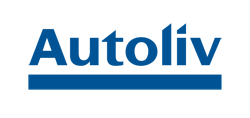Autoliv Enters New Market - Introduces the next generation safety control system
(Stockholm, October 25, 2011) --- Autoliv Inc. (NYSE: ALV and SSE: ALIV) – the worldwide leader in automotive safety systems – today announced that it has developed the world’s first system that combines the controls for vehicle brakes with the controls for vehicle restraints. The Company also announced that it has already been awarded production business for this new, enhanced, cost-efficient system.
The brake control system can provide key lifesaving functions such as Electronic Stability Control (ESC), Anti-lock braking (ABS) and Traction control (TCS). A study performed by United States Insurance Institute for Highway Safety (IIHS) concluded that ESC reduces the likelihood of all fatal crashes by 43%, fatal single-vehicle crashes by 56% and fatal single-vehicle rollovers by 77-80%.
In 2008, Autoliv became the first company to integrate the ESC inertial sensors with the control electronics for airbags and other restraint systems.
“Now, we are taking the lead with the next step in the integration of passive and active safety systems for vehicles”, explained David Scroggie, Senior Director, Autoliv Motion Control Systems.
“In this step, we are integrating not only the inertial sensors, but also the control logic for the brake and restraint control systems. We are thereby combining the controls of the two main life-saving technologies, available in modern vehicles: stability and restraints systems. The efficiency of merging the control systems provides significant savings to vehicle manufacturers and enhances performance compared to the traditional, separate systems.”
“This is also a key step in the evolution towards a single, comprehensive Safety Domain Controller, that coordinates all the safety systems in a vehicle”, continued David Scroggie, and adds:
“This also paves the way for new enhancements of the safety system. For instance, by using signals from our radar, vision and night vision systems, we can improve the performance of both the restraint system and the motion control of the vehicle”.
“This technological break-through, in active safety systems, is a major step forward in achieving our accident prevention strategy, " said Jan Carlson, President and CEO of Autoliv Inc.
Inquiries:
Jan Carlson, President & CEO, Autoliv Inc. Tel. +46 8 587 20 600
David Scroggie, Senior Director Motion Control Systems Tel. +1 248 223 8096
About Autoliv
Autoliv Inc., with its joint ventures, has 80 facilities with 46,000 employees in 29 countries. In addition, the Company has ten technical centers in nine countries around the world, with 21 test tracks, more than any other automotive safety supplier. Sales in 2010 grew to by 40% to nearly US $7.2 billion. The Company’s shares are listed on the New York Stock Exchange (NYSE: ALV) and its Swedish Depository Receipts on the OMX Nordic Exchange in Stockholm (ALIV sdb). For more information about Autoliv, please visit our company website at www.autoliv.com.
Safe Harbor Statement
This report contains statements that are not historical facts but rather forward-looking statements within the meaning of the Private Securities Litigation Reform Act of 1995 (PSLRA). All such statements are based upon our current expectations, various assumptions, and data available from third parties and apply only as of the date of this report. Our expectations and assumptions are expressed in good faith and we believe there is a reasonable basis for them. However, there can be no assurance that forward-looking statements will materialize or prove to be correct as these assumptions are inherently subject to risks and uncertainties such as without limitation, changes in general industry and market conditions, changes in and the successful execution of cost reduction initiatives and market reaction thereto, increased competition, changes in consumer preferences for end products, customer losses, bankruptcies, consolidations or restructuring, divestiture of customer brands, fluctuation in vehicle production schedules for which the Company is a supplier, continued uncertainty in program awards and performance, costs or difficulties related to the integration of any new or acquired businesses or technologies, pricing negotiations with customers, our ability to be awarded new business, product liability, warranty and recall claims and other litigation and customer reaction thereto, possible adverse results of pending or future litigation or infringement claims, negative impacts of governmental investigations and litigation related to the conduct of our business, legislative or regulatory changes, dependence on customers and suppliers, as well the risks identified in Item 1A “Risk Factors” in our Annual Report and Quarterly Report on Forms 10-K and 10-Q. Except for the Company’s ongoing obligation to disclose information under the U.S. federal securities laws, the Company undertakes no obligation to update publicly any forward-looking statements whether as a result of new information or future events. For any forward-looking statements contained in this or any other document, we claim the protection of the safe harbor for forward-looking statements contained in the PSLRA.

